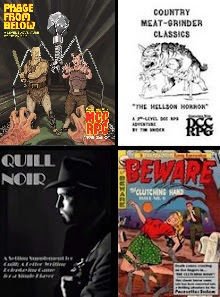 No. Enc.: 1d2
No. Enc.: 1d2Alignment: Chaotic
Movement: 120' (40')
Armor Class: 3
Hit Dice: 6
Attacks: 2 (claws plus special)
Damage: 1d8, 1d8, WIL drain
Save: F6
Morale: 10
Hoard Class: None
A Fear Feeder is a formless, shapeless mutant who feeds on fear and terror. Because of this requirement, they delight in terrorizing and tormenting children - hence the fear most child have of "The Boogeyman."
Feed Feeders are rumored to have come from another plane of existence, perhaps a miscalculated plane shift opened a portal to their home. Regardless, they have no real "form" on this plane. They, however, have a unique mental phantasm ability. They are able to reach into a viewer's mind and take on the form of what scares them the most. Ex: If a character is deathly afraid of spiders, it shall appear to be a giant spider. (This illusion manifests only as a creature/individual. If a character is afraid of heights, a Fear Feeder cannot take the form of a bottomless pit, for example.) Note that each PC will see the Fear Feeder in a different horrifying form since the illusion is mental rather than physical. Any character seeing a Fear Feeder in this illusionary form must save vs. stun attack or be terrorized by the image. If a save is failed, the Fear Feeder will immediately use its emotional vampirism ability, "draining" off 2d4 hit points from the terrorized individual, who will also be frozen in fear for 3 rounds. Any who make the save will see that is an illusion, but the "real" form of the Fear Feeder will remain undefined, shadowy, and nebulous at best.
Fear Feeders attack with a claw/claw attack (even if their illusionary form does not have claws or appears with a weapon). These claws hit for 1d8 hit points of damage. However, on a successful hit, a character must save vs. stun attack or lose a point of Willpower. This Willpower loss can be gained after one week's uninterrupted rest. Fear Feeders are nearly fearless themselves, hence the high morale score.
Fear Feeders have been known to kidnap children from their beds and spirit them away to some distant location where it can torment the child, feeding on his/her fear until the child is so drained and numb to the terrorizing illusions that they no longer feel anything. At that point, the Fear Feeder releases the child, emotionless, cold, distant, with dead unseeing eyes.
Mutations: mental phantasm (unique), emotional vampirsm (fear)
NOTE: This creature originally started out as a magical creature for Labyrinth Lord. But a little tinkering made it a grand other-planar menace for Mutant Future. Happy Halloween everyone!














































































































